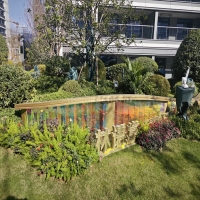Welcome to the website for landscape facilities products and knowledge.
How does the table’s design align with the needs of industries with high mobility or reconfiguration needs?
In today's rapidly evolving business landscape, industries characterized by high mobility and frequent reconfiguration demands are discovering innovative solutions through strategically designed tables. These specialized work surfaces transcend traditional furniture limitations by incorporating modular components, integrated mobility features, and adaptive configurations that directly address the core requirements of dynamic work environments.
The fundamental alignment between modern table design and high-mobility industries begins with integrated mobility solutions. Tables equipped with industrial-grade locking casters, lightweight yet durable materials, and streamlined profiles enable seamless transitions between different workspace configurations. This mobility proves particularly valuable in sectors like event management, collaborative tech spaces, educational institutions, and healthcare facilities where spatial requirements can change multiple times daily. The ability to quickly rearrange work surfaces without compromising stability or functionality represents a significant operational advantage.
Modularity stands as another critical design principle serving mobile industries. Tables featuring interchangeable components, expandable surfaces, and standardized connection systems allow organizations to create customized layouts that precisely match their evolving needs. This modular approach eliminates the traditional compromise between specialized furniture and flexibility, enabling companies to maintain specialized work areas while preserving the ability to rapidly reconfigure spaces. The economic benefits extend beyond initial acquisition, as modular systems reduce long-term costs associated with workspace changes and expansions.
Ergonomics and user experience receive heightened attention in mobile table designs. Unlike static furniture that assumes consistent usage patterns, reconfigurable tables incorporate adjustable height mechanisms, cable management systems that accommodate frequent moves, and surfaces resistant to damage during transportation. These features ensure that mobility doesn't come at the expense of user comfort or productivity, addressing a common concern in dynamic work environments where employee well-being directly impacts operational outcomes.
The technological integration within modern mobile tables further enhances their alignment with high-mobility industries. Built-in power distribution, wireless charging capabilities, and connectivity solutions remain fully functional regardless of table position or configuration. This technological seamlessness supports the increasingly hybrid nature of modern work, where teams might collaborate in person one hour and connect with remote colleagues the next, all while maintaining access to essential tools and resources.
Sustainability considerations have also influenced the evolution of mobile table design. Manufacturers increasingly utilize recycled materials, create easily repairable components, and design for disassembly - all features that resonate with industries prioritizing environmental responsibility alongside operational flexibility. This dual focus on sustainability and adaptability represents a significant advancement over earlier generations of mobile furniture, which often sacrificed durability or environmental considerations for the sake of portability.
As workplace dynamics continue to evolve, the relationship between table design and industry needs grows increasingly sophisticated. The most successful implementations recognize that true alignment extends beyond physical mobility to encompass operational workflows, technological requirements, and human factors. By viewing tables not as isolated pieces of furniture but as integrated elements within larger workspace ecosystems, organizations across multiple sectors can leverage design innovations to support their unique mobility and reconfiguration requirements while maintaining productivity, comfort, and aesthetic coherence.
Related search:

Recommendation
Metal and acrylic color-changing combined curtain wall for large-scale public landscape facilities